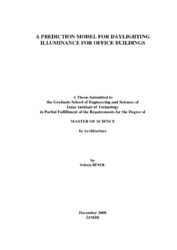Please use this identifier to cite or link to this item:
https://hdl.handle.net/11147/3970Full metadata record
| DC Field | Value | Language |
|---|---|---|
| dc.contributor.advisor | Kazanasmaz, Zehra Tuğçe | en |
| dc.contributor.author | Binol, Selcen | - |
| dc.date.accessioned | 2014-07-22T13:52:50Z | - |
| dc.date.available | 2014-07-22T13:52:50Z | - |
| dc.date.issued | 2008 | en |
| dc.identifier.uri | http://hdl.handle.net/11147/3970 | - |
| dc.description | Thesis (Master)--İzmir Institute of Technology, Architecture, İzmir, 2008 | en |
| dc.description | Includes bibliographical references (leaves: 94-100) | en |
| dc.description | Text in English; Abstract: Turkish and English | en |
| dc.description | xii, 130 leaves | en |
| dc.description.abstract | Daylight is a primary light source for the office buildings where a comfortable and an efficient working environment should be provided mostly during day time. Evidence that daylight is desirable can be found in research as well as in observations of human behavior and the arrangement of office space. A prediction model was then developed to determine daylight illuminance for the office buildings by using Artificial Neural Networks (ANNs). A field study was performed to collect illuminance data for four months in the subject building of the Faculty of Architecture in .zmir Institute of technology. The study then involved the weather data obtained from the local Weather Station and building parameters from the architectural drawings. A three-layer ANNs model of feed-forward type was constructed by utilizing these parameters. Input variables were date, hour, outdoor temperature, solar radiation, humidity, UV Index, UV dose, distance to windows, number of windows, orientation of rooms, floor identification, room dimensions and point identification. Illuminance was used as the output variable. The first 80 of the data sets were used for training and the remaining 20 for testing the model. Microsoft Excel Solver used simplex optimization method for the optimal weights. Results showed that the prediction power of the model was almost 97.8%. Thus the model was successful within the sample measurements. NeuroSolutions Software performed the sensitivity analysis of the model. On the top of daylight consideration, this model can supply beneficial inputs in designing stage and in daylighting performance assessment of buildings by making predictions and comparisons. Investigation about this subject can be able to support the office buildings. having intended daylighting comfort conditions. | en |
| dc.language.iso | en | en_US |
| dc.publisher | Izmir Institute of Technology | en_US |
| dc.rights | info:eu-repo/semantics/openAccess | en_US |
| dc.subject.lcc | NA2794. B6146 2008 | en |
| dc.subject.lcsh | Daylighting | en |
| dc.subject.lcsh | Light in architecture | en |
| dc.subject.lcsh | Office buildings--Lighting | en |
| dc.title | A prediction model for daylighting illuminance for office buildings | en_US |
| dc.type | Master Thesis | en_US |
| dc.institutionauthor | Binol, Selcen | - |
| dc.department | Thesis (Master)--İzmir Institute of Technology, Architecture | en_US |
| dc.relation.publicationcategory | Tez | en_US |
| item.fulltext | With Fulltext | - |
| item.openairetype | Master Thesis | - |
| item.cerifentitytype | Publications | - |
| item.grantfulltext | open | - |
| item.openairecristype | http://purl.org/coar/resource_type/c_18cf | - |
| item.languageiso639-1 | en | - |
| Appears in Collections: | Master Degree / Yüksek Lisans Tezleri Sürdürülebilir Yeşil Kampüs Koleksiyonu / Sustainable Green Campus Collection | |
Files in This Item:
| File | Description | Size | Format | |
|---|---|---|---|---|
| T000757.pdf | MasterThesis | 5.72 MB | Adobe PDF |  View/Open |
CORE Recommender
Page view(s)
180
checked on Oct 7, 2024
Download(s)
106
checked on Oct 7, 2024
Google ScholarTM
Check
Items in GCRIS Repository are protected by copyright, with all rights reserved, unless otherwise indicated.